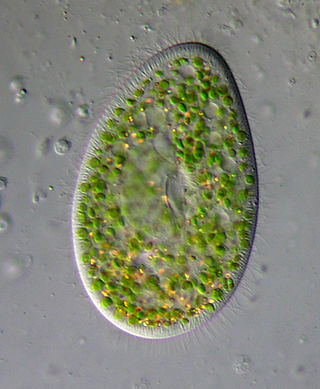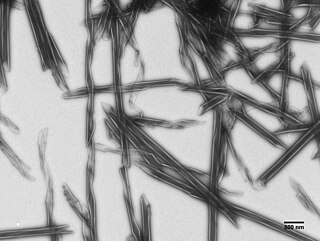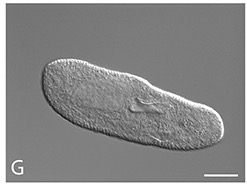Related Research Articles

An endosymbiont or endobiont is an organism that lives within the body or cells of another organism. Typically the two organisms are in a mutualistic relationship. Examples are nitrogen-fixing bacteria, which live in the root nodules of legumes, single-cell algae inside reef-building corals, and bacterial endosymbionts that provide essential nutrients to insects.

Paramecium is a genus of eukaryotic, unicellular ciliates, widespread in freshwater, brackish, and marine environments. Paramecia are often abundant in stagnant basins and ponds. Because some species are readily cultivated and easily induced to conjugate and divide, they have been widely used in classrooms and laboratories to study biological processes. Paramecium species are commonly studied as model organisms of the ciliate group and have been characterized as the "white rats" of the phylum Ciliophora.

The Chlamydiota are a bacterial phylum and class whose members are remarkably diverse, including pathogens of humans and animals, symbionts of ubiquitous protozoa, and marine sediment forms not yet well understood. All of the Chlamydiota that humans have known about for many decades are obligate intracellular bacteria; in 2020 many additional Chlamydiota were discovered in ocean-floor environments, and it is not yet known whether they all have hosts. Historically it was believed that all Chlamydiota had a peptidoglycan-free cell wall, but studies in the 2010s demonstrated a detectable presence of peptidoglycan, as well as other important proteins.

Structural inheritance or cortical inheritance is the transmission of an epigenetic trait in a living organism by a self-perpetuating spatial structures. This is in contrast to the transmission of digital information such as is found in DNA sequences, which accounts for the vast majority of known genetic variation.

Wolbachia is a genus of gram-negative bacteria infecting many species of arthropods and filarial nematodes. The symbiotic relationship ranges from parasitism to obligate mutualism. It is one of the most common parasitic microbes of arthropods, and is possibly the most widespread reproductive parasite bacterium in the biosphere. Its interactions with hosts are complex and highly diverse across different host species. Some host species cannot reproduce, or even survive, without Wolbachia colonisation. One study concluded that more than 16% of neotropical insect species carry bacteria of this genus, and as many as 25 to 70% of all insect species are estimated to be potential hosts.
Tracy Morton Sonneborn was an American biologist. His life's study was ciliated protozoa of the group Paramecium.

Paramecium bursaria is a species of ciliate found in marine and brackish waters. It has a mutualistic endosymbiotic relationship with green algae called Zoochlorella. About 700 Chlorella cells live inside the protist's cytoplasm and provide it with food, while the Paramecium provides the algae with movement and protection. P. bursaria is 80–150 μm long, with a wide oral groove, two contractile vacuoles, and a single micronucleus as well as a single macronucleus. P. bursaria is the only species of Paramecium that forms symbiotic relationships with algae, and it is often used in biology classrooms both as an example of a protozoan and also as an example of symbiosis.
Symbiotic bacteria are bacteria living in symbiosis with another organism or each other. For example, rhizobia living in root nodules of legumes provide nitrogen fixing activity for these plants.
Microbial genetics is a subject area within microbiology and genetic engineering. Microbial genetics studies microorganisms for different purposes. The microorganisms that are observed are bacteria and archaea. Some fungi and protozoa are also subjects used to study in this field. The studies of microorganisms involve studies of genotype and expression system. Genotypes are the inherited compositions of an organism. Genetic Engineering is a field of work and study within microbial genetics. The usage of recombinant DNA technology is a process of this work. The process involves creating recombinant DNA molecules through manipulating a DNA sequence. That DNA created is then in contact with a host organism. Cloning is also an example of genetic engineering.
Phycodnaviridae is a family of large (100–560 kb) double-stranded DNA viruses that infect marine or freshwater eukaryotic algae. Viruses within this family have a similar morphology, with an icosahedral capsid. As of 2014, there were 33 species in this family, divided among 6 genera. This family belongs to a super-group of large viruses known as nucleocytoplasmic large DNA viruses. Evidence was published in 2014 suggesting that specific strains of Phycodnaviridae might infect humans rather than just algal species, as was previously believed. Most genera under this family enter the host cell by cell receptor endocytosis and replicate in the nucleus. Phycodnaviridae play important ecological roles by regulating the growth and productivity of their algal hosts. Algal species such Heterosigma akashiwo and the genus Chrysochromulina can form dense blooms which can be damaging to fisheries, resulting in losses in the aquaculture industry. Heterosigma akashiwo virus (HaV) has been suggested for use as a microbial agent to prevent the recurrence of toxic red tides produced by this algal species. Phycodnaviridae cause death and lysis of freshwater and marine algal species, liberating organic carbon, nitrogen and phosphorus into the water, providing nutrients for the microbial loop.

In taxonomy, Roseobacter is a genus of the Rhodobacteraceae. The Roseobacter clade falls within the {alpha}-3 subclass of the class Alphaproteobacteria. The first strain descriptions appeared in 1991 which described members Roseobacterlitoralis and Roseobacterdenitrificans, both pink-pigmented bacteriochlorophyll a-producing strains isolated from marine algae. The role members of the Roseobacter lineage play in marine biogeochemical cycles and climate change cannot be overestimated. Roseobacters make up 25% of coastal marine bacteria and members of this lineage process a significant portion of the total carbon in the marine environment. Roseobacter clade plays an important role in global carbon and sulphur cycles. It can also degrade aromatic compounds, uptake trace metal, and form symbiotic relationship. In term of its application, Roseobacter clade produces bioactive compounds, has been used widely in aquaculture and quorum sensing.

Bacillus anthracis is a gram-positive and rod-shaped bacterium that causes anthrax, a deadly disease to livestock and, occasionally, to humans. It is the only permanent (obligate) pathogen within the genus Bacillus. Its infection is a type of zoonosis, as it is transmitted from animals to humans. It was discovered by a German physician Robert Koch in 1876, and became the first bacterium to be experimentally shown as a pathogen. The discovery was also the first scientific evidence for the germ theory of diseases.

Paramecium aurelia are unicellular organisms belonging to the genus Paramecium of the phylum Ciliophora. They are covered in cilia which help in movement and feeding.Paramecium can reproduce sexually, asexually, or by the process of endomixis. Paramecium aurelia demonstrate a strong "sex reaction" whereby groups of individuals will cluster together, and emerge in conjugant pairs. This pairing can last up to 12 hours, during which the micronucleus of each organism will be exchanged. In Paramecium aurelia, a cryptic species complex was discovered by observation. Since then, some have tried to decode this complex using genetic data.
Moraxella osloensis is a Gram-negative oxidase-positive, aerobic bacterium within the family Moraxellaceae in the gamma subdivision of the purple bacteria.
Paramecium sonneborni is a species of unicellular organisms belonging to the genus Paramecium of the phylum Ciliophora. It was first isolated in Texas and named after Tracy M. Sonneborn. It is a member of the Paramecium aurelia species complex. They are covered in cilia and are distinguished by their difference in mating patterns and enzyme patterns. The length of Paramecium sonneborni is between 130 and 186 μm with a mean length of 154μm. It is the newest member of the Paramecium aurelia species complex. The current Paramecium sonneborni strains, so far, reveal very low viability in the generations and are a result of allopatric speciation.
Arsenophonus is a genus of Morganellaceae, of the Gammaproteobacteria. Members of the Arsenophonus genus are increasingly discovered bacterial symbionts of arthropods that are estimated to infect over 5% of arthropod species globally and form a variety of relationships with hosts across the mutualism parasitism continuum. Arsenophonus bacteria have been identified in a diversity of insect taxa, including economically important species such as the Western honey bee and the rice pest Nilaparvata lugens.

R bodies are polymeric protein inclusions formed inside the cytoplasm of bacteria. Initially discovered in kappa particles, bacterial endosymbionts of the ciliate Paramecium, R bodies have since been discovered in a variety of taxa.

Paramecium biaurelia is a species of unicellular ciliates under the genus Paramecium, and one of the cryptic species of Paramecium aurelia. It is a free-living protist in water bodies and harbours several different bacteria as endosymbionts. Although the bacteria are parasites by definition, they also exhibit mutual relationship with the protist by providing survival benefits. It is used as an organism model in the study of the effects of gravitational forces in different environments.

Amoebozoa of the free living genus Acanthamoeba and the social amoeba genus Dictyostelium are single celled eukaryotic organisms that feed on bacteria, fungi, and algae through phagocytosis, with digestion occurring in phagolysosomes. Amoebozoa are present in most terrestrial ecosystems including soil and freshwater. Amoebozoa contain a vast array of symbionts that range from transient to permanent infections, confer a range of effects from mutualistic to pathogenic, and can act as environmental reservoirs for animal pathogenic bacteria. As single celled phagocytic organisms, amoebas simulate the function and environment of immune cells like macrophages, and as such their interactions with bacteria and other microbes are of great importance in understanding functions of the human immune system, as well as understanding how microbiomes can originate in eukaryotic organisms.
Plasmagene is a term used to describe genetic elements that exist outside of the nucleus, typically within the cytoplasm of a cell. These elements are usually associated with organelles like mitochondria and chloroplasts, which contain their own genetic material and replicate independently of the nuclear genome. Plasmagene theory as proposed by Tracy Sonneborn has significantly contributed to the understanding of non-Mendelian inheritance patterns, where traits are passed through cytoplasmic inheritance rather than through nuclear DNA.
References
- ↑ Sonneborn, T. M. (1950). "Paramecium in modern biology". BIOS. 21 (1): 31–43.
- ↑ Takayanagi, Tan; Hayashi, Shinji (1964). "Cytological and Cytogenetical Studies on Paramecium polycaryum. V. Lethal Interactions in Certain Stocks". Journal of Eukaryotic Microbiology. 11 (1): 128–132. doi:10.1111/j.1550-7408.1964.tb01733.x. PMID 14119554.
- ↑ Lawrence E. (1999). Henderson's Dictionary of biological terms. London: Longman Group Ltd. ISBN 0-582-22708-9.
- ↑ Rieger R. Michaelis A.; Green M. M. (1976). Glossary of genetics and cytogenetics: Classical and molecular. Heidelberg - New York: Springer-Verlag. ISBN 0-387-07668-9.
- ↑ Brown, C. H. (1950). "Elimination of Kappa Particles from 'Killer' Strains of Paramecium aurelia by Treatment with Chloromycetin". Nature. 166 (4221): 527. Bibcode:1950Natur.166..527B. doi: 10.1038/166527A0 . PMID 14780133.
- ↑ Kappa Particles in mediLexicon
- ↑ Kappa Particles in McGraw-Hill Science & Technology Dictionary
- ↑ Pond, F. R.; Gibson, I.; Lalucat, J.; Quackenbush, R. L. (1989-03-01). "R-body-producing bacteria". Microbiological Reviews. 53 (1): 25–67. doi:10.1128/mr.53.1.25-67.1989. ISSN 0146-0749. PMC 372716 . PMID 2651865.